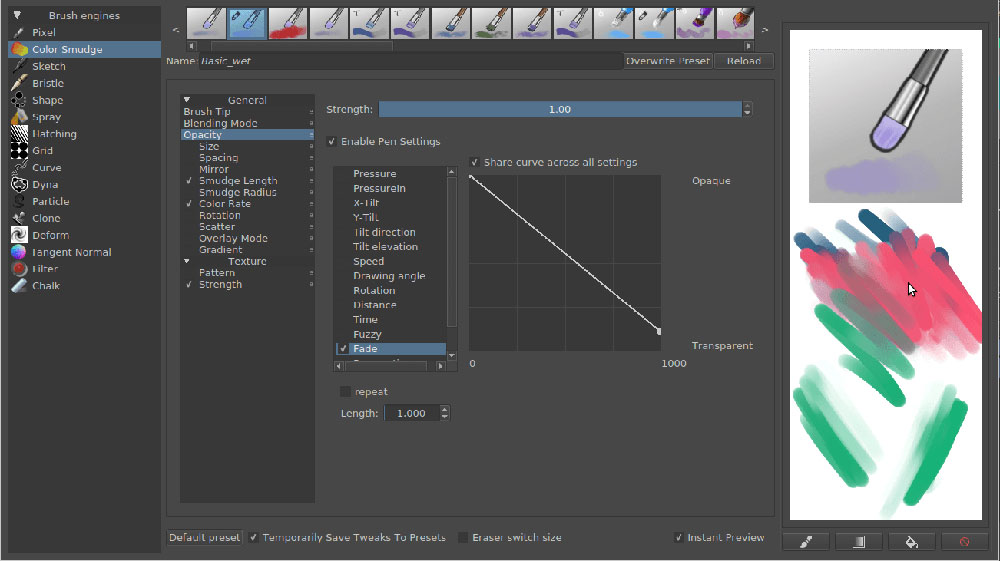

Higher values than this will be lighter versions of the current foreground color, and lower, darker versions of the current color. This is the lightness level that will be the same as your current foreground color. There are three sliders here, to control the exact feel of the current brush tip in Lightness or Gradient mode: Neutral point

This allows image stamps where you can choose the color, but preserve highlights and shadows, and can even create an effect of thick paint in a brush stroke by simulating the highlights and shadows caused by the texture of the paint and brush stroke (sometimes called an “impasto” effect). The Lightness values of the brush tip image (if thinking in HSL mode) are preserved, so dark parts of the image are dark, and bright parts are bright. Transparency is preserved as it is in Image Stamp mode, but colors or gray tones in the brush are replaced by the foreground color. New in version 4.3: Combines the features of Alpha Mask and Image Stamp modes. Use the brush tip image exactly as it is. Lighter areas will be interpreted as more transparent. ¶ Alpha Maskįor colored brushes, don’t paint the actual colors, but make a grayscale brush tip that will be colored by your selected foreground/background color. Brush Mode ¶ĭifferent modes shown with different brush tips. Spacingĭistance between the brush tip impressions. This can be fairly large! When painting with variable size (for instance governed by pressure), this is the base for the calculations. There are four more options that influence the initial bitmap brush tip you start painting with: Size We strongly recommend every Krita user to share brush tips in GBR and GIH format and more complex brushes as Krita presets.Īll predefined brush tips are shown in one selector. Note that the definition of ABR brushes has been reverse engineered since Adobe does not make the specification public. We support many of the features of these brush files, though some advanced features are not supported yet. Krita does not yet support all the parameters yet.
Krita brushes soecial effects series#
Gimp Image Hose brush tip: contains a series of brush tips that are painted randomly or in order after each other. Krita is (mostly) compatible with the brush tip definitions files of these applications: abr If you have used other applications like GIMP or Photoshop, you will have used this kind of brush. The first value is the brush size at which precision is at last 5, and the second is the size-difference at which the precision will decrease.įor example: A brush with ‘’starting brush size’’ 10 and ‘’delta’’ 4, will have… This allows you to set the precision linked to the size. You’d want an inking brush to have a precision of 5 at all times, but a big filling brush for painting doesn’t require such precision, and can be easily sped up by setting precision to 1. The lower, the faster the brush, but the worse the rendering looks. This changes how smooth the brush is rendered. This option is best used in combination with Auto Spacing. On the left without smooth lines, and the right with. In the below example, both strokes are drawn with a default brush with fade set to 0. This toggles the super-smooth anti-aliasing. In the below picture, the three examples on right are with auto spacing, 0, 1 and 5 respectively. The result is fine control over the spacing. Ticking this will set the brush-spacing to a different (quadratic) algorithm. In the below picture, the three examples on the left are with spacing 0, 1 and 5. This affects how far brushes are spaced apart. In the example below, the brush is set with randomness 0%, 50% and 100% respectively. This changes the randomness of the density. In the example below, the brush is set with density 0%, 50% and 100% respectively. This determines how much area the brush-covers over its size: It makes it noisy. This gives the amount of tips related to the ratio. This changes the angle a which the brush is at.

With fade separately horizontal and vertical. Fade has a different effect per mask-type, so don’t be alarmed if it looks strange, perhaps you have the wrong mask-type. You can click the chain-symbol to lock and unlock these settings. Out of the three auto brushes, this is the slowest. This one uses the gaussian algorithm to determine the fade. This one’s fade is controlled by a curve! Gaussian Of the three auto brushes, this is the fastest. The Fade parameter produces the below results. Types ¶įirst, there are three mask-types, with each the circle and square shape: Default These brush tips are generated by Krita through certain parameters.


 0 kommentar(er)
0 kommentar(er)
